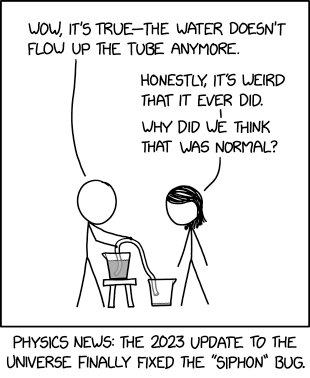Siphon

ADDITIONAL NOTES: Fixed a bug that caused some rocks to generate virtually infinite heat while just sitting there.

ADDITIONAL NOTES: Fixed a bug that caused some rocks to generate virtually infinite heat while just sitting there.
Cueball and Megan have set up a simple experiment to test how a siphon works, using the gravitational force on a lower portion of liquid-filled tube, atmospheric pressure on the upper reservoir, and molecular cohesion within the liquid, to move a liquid upwards through a bit of tube at a higher gravitational potential. In short, the liquid passes over a higher peak to reach a lower exit. Randall has also mentioned siphons in Europa Water Siphon and in How To (section "How to Throw a Pool Party").
Siphons are commonly used in modern society (e.g., most American residential toilets are flushed by siphon action). Siphons should not be confused with capillary action.
Apparently, even though Cueball and Megan have set up the experiment correctly, the water no longer demonstrates a siphon by flowing from the upper bucket to the lower. Cueball observes in surprise that "it's true," that siphoning doesn't work anymore. Thus indicating that this is a very recent development, and Megan remarks that it was honestly weird that it ever worked, and muses over why we ever thought that was a normal thing.
The punchline of the comic comes in the caption, which delivers a piece of Physics News: "The 2023 update to the universe finally fixed the "siphon" bug." The joke here is that the entire complex and multifaceted system of physics in and of itself is treated as though it is simply the coded logic running the universe (or perhaps the sometimes unintentional result of various default configuration options like in a video game - see 1620: Christmas Settings), and that siphoning (rather than being an interesting physical phenomenon worth studying) was nothing more than a bug in the Universe. It has now been fixed, somehow and for some reason, being considered a glitch and not the intended behavior.
In reality, siphons still very much exist in our universe. Siphons require filling beforehand to function, either by initially actively sucking liquid through or by first immersing the siphon tube in any compatible liquid then ensuring it retains its contents as it draped over the obstacle and each end positioned properly into the respective receptacle, so it is plausible to imagine skeptical people “proving” they do not function by refraining from providing the initial priming. However, the small amount of water in the bottom of the bucket near Megan indicates that there was at least some water in the tube, and that this just ran down on either side, leaving the tube empty and a bit of water in Megan's bucket and a bit more in Cueball's bucket. So they did set up the experiment correctly, but since the latest update siphons do not work anymore. Or as they state it, the universe now works correctly and the siphon bug has been corrected.
A siphon requires that the weight of the liquid column on the "higher" side of the channel peak not exceed atmospheric pressure, or else the liquid will split, leaving a partial vacuum. The observed failure could be caused by several kinds of changes to the universe. If there was a significant decrease in the ratio between the pressure of Earth's atmosphere and the force of gravity, the siphon would stop working. Eventually, the water in the "lower" side of the tube would dribble out, letting air in, and the water in the "higher" side would also drain back into the reservoir. If the density of water increased enormously, the increased weight of the liquid column would lead to a similar failure. If the molecular cohesion of water decreased drastically and the flow rate of the siphon was slow, air could bubble into the "lower" end more quickly than the water was flowing through, and eventually the tube would empty. The siphon could also fail more mundanely if the water had a lot of gas dissolved in it under pressure (as with soda water), because the gas would come out of solution and collect at the highest point of the tube.
The idea that we live in a computer simulation is also prevalent in our modern pop culture, most famously shown in The Matrix (See 566: Matrix Revisited).
The title text is an additional note to the 2023 physics update stating that the update has: "Fixed a bug that caused some rocks to generate virtually infinite heat while just sitting there."
This is a reference to radioactive materials that keep emitting energy (heat) almost indefinitely (on a human timescale). This is mainly a reference to uranium and thorium and their decay chain.
This is similar to the comic 2115: Plutonium, because plutonium (though man-'made', during nucleosynthesis) is used to power spacecraft. In that comic the title text has the same idea that someone controls the universe: It's like someone briefly joined the team running the universe, introduced their idea for a cool mechanic, then left, and now everyone is stuck pretending that this wildly unbalanced dynamic makes sense.
The entire comic is one of many where Randall muses over strange aspects of our universe, and wonders why we (people) ever think that it seems normal, the way the Universe works (or how humans work - see for instance 1268: Alternate Universe).